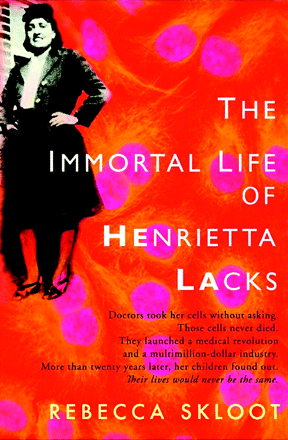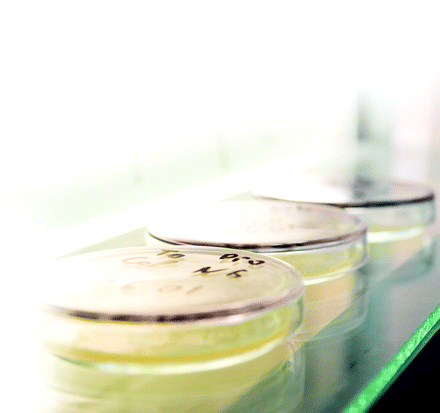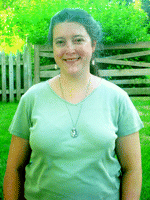Henrietta & HeLa: A Lady and her Legacy Reconnected
- Tanya Jelacic, PhD

The Immortal Life of Henrietta Lacks. Rebecca Skloot. New York, New York: Crown Publishers; 2010. 369 pages. $26.00. ISBN: 9781400052172.
After nearly sixty years of being overshadowed by the HeLa cell line and the apocryphal Helen Lane, Henrietta Lacks is finally having her day. She stands on the cover of Rebecca Skloot’s The Immortal Life of Henrietta Lacks with a big smile and a confident hands-on-hips stance. It seems as if she knew that this day would come, when her story would be told and her suffering and that of her family justified to the world. The author, Rebecca Skloot, first heard about Henrietta while taking a community college biology class in which a great deal was said about HeLa, but only Henrietta’s name and the fact that she was black were revealed. A deep curiosity about Henrietta took hold and Skloot resolved to one day bring the full story of Henrietta Lacks to light. It would take more than a decade filled with intensive and intimate reporting before Skloot’s dream was realized with the publication of The Immortal Life of Henrietta Lacks.

The Immortal Life of Henrietta Lacks has three main overlapping and intertwining storylines: it tells the life story of the woman Henrietta Lacks, it chronicles the uses and misuses of the HeLa cell line, and it follows the lives of the family members Henrietta left behind. All three are well presented and explored in depth. Henrietta’s biography is covered in the book’s early chapters. Along with the basic details of Henrietta’s brief life, a sense of Henrietta as a person emerges. She was the kind-hearted center of her family, who always had home-cooked food on hand should anyone drop by hungry. She was fun-loving, slipping out at night to swing dance with her cousin Sadie. She was also every inch a lady, taking care and pride in her appearance, especially her red painted finger and toenails. Above all, she was a loving and devoted mother to her five children.
The story of HeLa begins in chapter four with the establishment of the primary culture at Johns Hopkins. Although her primary interest is in the personal stories of Henrietta and her family, Skloot invests just as much care in researching the lab in which HeLa was first cultured. Among others, Skloot interviews Howard Jones, the gynecologist who diagnosed Henrietta, and Mary Kubicek, the technician who started the initial culture. Because of these firsthand accounts, the lab is as strongly evoked as Henrietta. Rather than seeming quaint, George Gey’s cell culture lab of 1951 seems positively barbaric by current safety standards. Mouth pipetting of samples of human and animal tissues was the norm. Indeed, there was little separation between the lab work and the lab workers on any level; “the teapot sat next to a Bunsen burner” and “a long stone culture bench...doubled as a break table.” Proving that Skloot is not exaggerating, there is a photo of two ladies lunching at the lab bench in the center of the book. The initial culture procedure performed by Mary Kubicek is detailed step by step, giving the reader a feeling of being in the room as it happened. It is fascinating material, excellently rendered.
The personal stories of Henrietta’s children begin in chapter fifteen. The loss of their mother was hard on all the Lacks children, but particularly for her younger daughter Deborah, who would have no firsthand memories of her mother and very few tangible mementoes. Deborah’s childhood would be marred by abuse and her adulthood marred by the conundrum of her mother’s cells. Deborah and her siblings didn’t find out about HeLa until 1973 when geneticists came calling seeking blood samples. They took her blood but gave her little information in return. Between her lack of education and urban legends of white Hopkins doctors kidnapping black people to perform medical experiments on them, Deborah would initially believe her mother was being subjected to what amounted to torture. It would not be until 2001 that Deborah and her brother Zakariyya would finally get a proper introduction to HeLa cells in the lab of Christoph Lengauer, where they would both be awed by their beauty under the microscope.
After finding out about the scientific breakthroughs made possible by HeLa, Deborah wanted her mother’s name to be known to the public and her contribution recognized, but her brothers wanted a share in the millions of dollars generated by HeLa sales. To the Lacks men, George Gey was a thief who stole their mother’s cells and cheated them out of a fortune. However, as Skloot frequently points out, Gey had no financial motives and gave away HeLa cultures freely to all who asked. She further establishes that he never sought to profit from his science. He turned down an opportunity to establish a commercial cell culture lab and didn’t bother to patent his roller drum, which would have been very lucrative. Indeed, if not for the efforts of his frugal wife Margaret, Gey probably would have run into severe debt. Although the primary focuses of the book are Henrietta, her family, and HeLa, it is also tangentially a biography of George Gey. Next to Henrietta and Deborah, he is the most vibrant figure in the book. Gey is the only scientist whose background is described and whose character is drawn in three dimensions. He comes to life as the fervent quintessential scientist, a man of humble origins who built or improvised much of the equipment in his lab and who attempted to culture every scrap of tissue he could get. His failing is his blind devotion to science. Gey’s greatest disappointment in life was that his own tumor was not cultured to create a GeGe cell line; if his “cancer was going to kill him, he wanted it to help advance science in the process.” In George Gey’s opinion Henrietta Lacks had the best possible legacy in HeLa.
HeLa, and human tissue research in general, has a checkered history, and there are some scary doctors in the book. Chester Southam injected HeLa cells into his cancer patients with no explanation of what he was doing. In stark contrast to George Gey, David Golde, who developed the Mo cell line, definitely had financial interests. While simultaneously brokering a multimillion dollar deal with a biotech company for Mo, he badgered the patient into renouncing any rights to products derived from his tissue. These doctors have stimulated court cases and legislation.
The Immortal Life of Henrietta Lacks is by turns fascinating and horrifying, but always compelling. The scientific reader may be tempted to skip the portions dealing with the tribulations of the Lacks family, but that would be to miss the point of this very topical and relevant book. Robert Stevenson, a former president of the American Type Culture Collection, captures the point very well: “Scientists don’t like to think of HeLa cells as being little bits of Henrietta because it’s much easier to do science when you dissociate your materials from the people they come from.” There have been many changes in how biomedical research is done since 1951, including lab safety training, ethics training, IRBs, informed consent forms, and HIPAA. The Immortal Life of Henrietta Lacks is a potent reminder of why they exist and how much better off we all are that they do.

- Copyright © 2010

Tanya Jelacic, PhD, received her doctoral degree in Pharmacology from the Mayo Graduate School in Rochester, MN. She has conducted basic research at the Children’s Hospital, Boston, and the National Cancer Institute at Frederick, MD. She currently works at the United States Army Medical Research Institute of Infectious Diseases.



